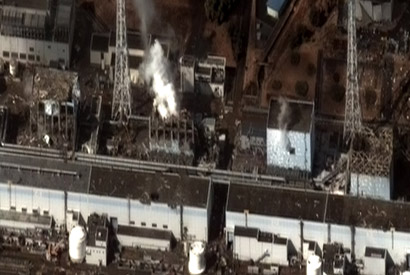
RadWatch team members note that the radioisotopes they have detected from Fukushima have been thousands of times weaker than what the general public is exposed to naturally on a daily basis. They plan to distinguish Fukushima radioisotope signals from natural sources.
“We are using state-of-the-art nuclear radiation detection instruments that can measure extremely small quantities of radioisotopes far before they pose any health risk,” said Vetter. “Being able to detect or measure radiation does not mean there’s a health risk, and that is what we want the public to understand.”
The scientists pointed out that there are many sources of naturally occurring radioactive elements around us that affect the air we breathe, the foods we eat and the water we drink. Some, such as potassium-40, uranium and thorium, were created before Earth was formed, and their decay products, including radon, radium and polonium, remain today in the environment. Others, including carbon-14 and beryllium-7, are produced when atoms in the atmosphere interact with cosmic rays from our solar system.
Even a walk along the beach might generate additional exposure to thorium, a radioisotope naturally found in the mineral monazite in black sand. The mineral may originate from eroding granite and rock, and its levels easily can fluctuate, depending upon its geological origin.
Eye on Fukushima
RadWatch evolved from a UC Berkeley air and water monitoring project that began in the wake of the disastrous failure of reactors at Japan’s Fukushima Daiichi nuclear power plant three years ago. The nuclear meltdown occurred after the country was hit by a magnitude 9.0 earthquake – one of the most powerful ever recorded – and a subsequent tsunami.
It did not take long before the shock of the disaster in Japan turned into concern among many members of the public that harmful levels of radiation from Fukushima would travel across the Pacific Ocean to the western United States.
Rather than speculate on exposures, Vetter and his students set up basic equipment on the roof of Etcheverry Hall on campus to monitor air and rainwater and determine whether there were increases in atmospheric radiation from Fukushima. They later expanded testing to include a large range of food and environmental samples, and this allowed them to detect fluctuations of radioactivity from Fukushima.
Because of the strong public interest in environmental radiation levels, the RadWatch team upgraded its rooftop monitoring equipment and is providing the results to the public continuously in near real-time.
Even during the height of radiation releases from the Japanese nuclear plant, the researchers calculated that radiation levels in the air were so low that it would take more than 100 years before the exposure through breathing equaled one round trip flight from San Francisco to Washington, D.C.
In response to concerns by the public and models predicting the arrival of radioactivity from Fukushima via Pacific Ocean currents, the researchers expanded the data to include measurements from fish, seaweed and crab. The project is also tied to the Kelp Watch 2014 initiative, a partnership with California State University-Long Beach to measure signs over the next year of radiation contamination in kelp found on the Pacific coast.
“The RadWatch project is a great example of how UC Berkeley combines research with student training and public education,” said Vetter, who is also head of the Applied Nuclear Physics Program at Lawrence Berkeley National Laboratory. “We see this as a core part of our mission.”
RELATED INFORMATION
